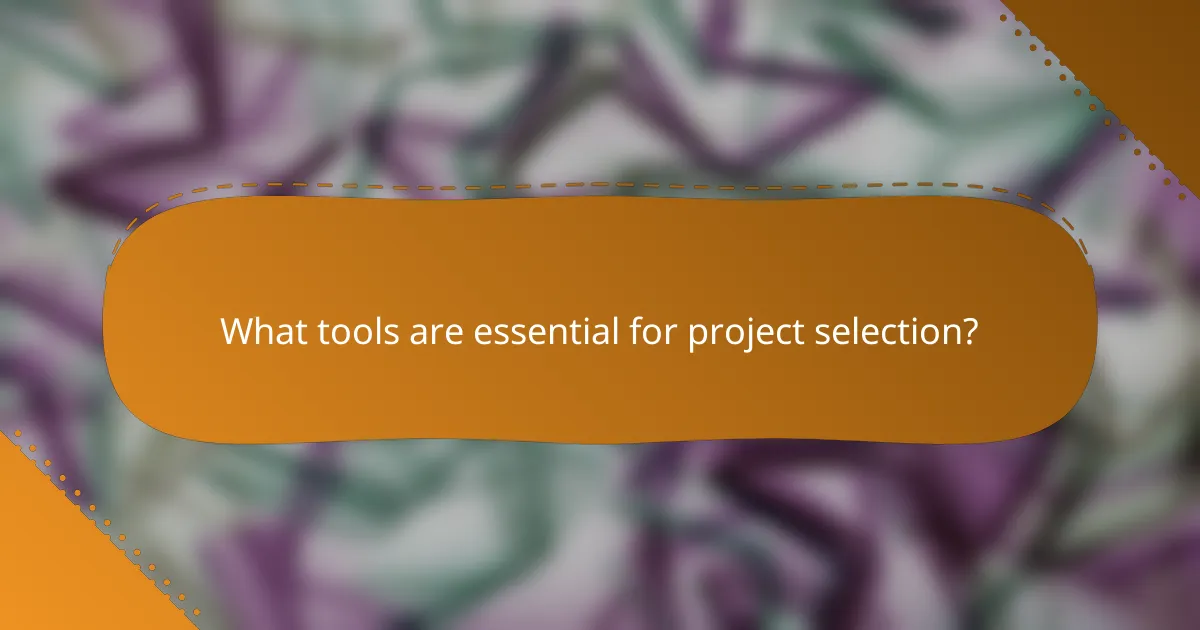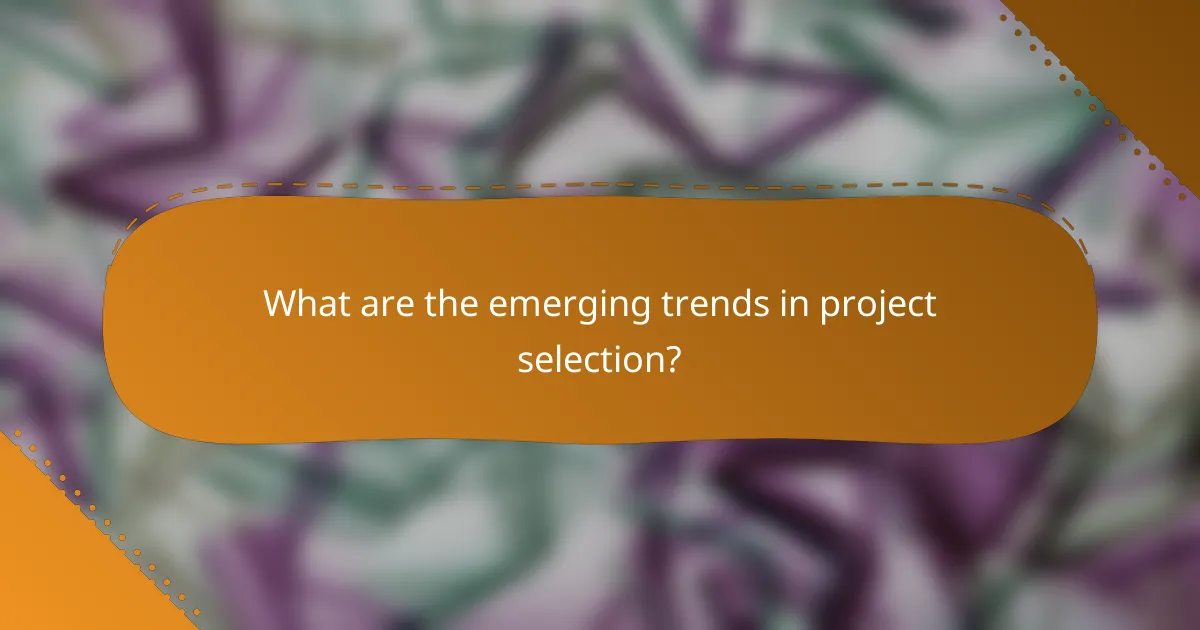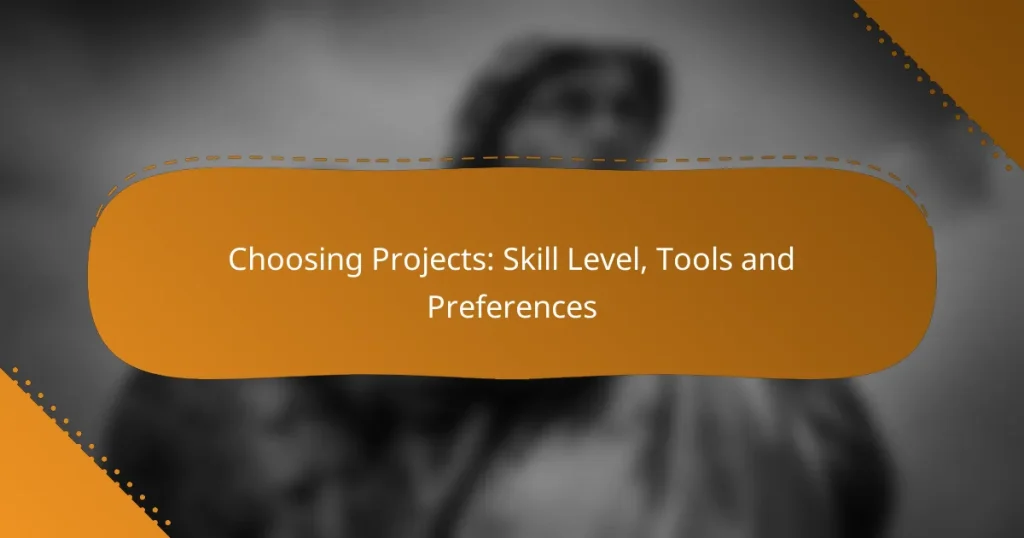Choosing the right projects is crucial for personal and professional growth, as it involves aligning your skill level with tasks that challenge you without causing frustration. Utilizing essential tools like project management software and collaboration platforms can streamline this selection process, enhancing both communication and execution. Additionally, considering your personal preferences ensures that the projects you undertake resonate with your interests and values, leading to a more fulfilling experience.

How to choose projects based on skill level?
Choosing projects based on skill level involves assessing your current abilities and selecting tasks that match or slightly challenge those skills. This approach helps ensure a productive learning experience while preventing frustration from overly complex projects.
Beginner-friendly projects
Beginner-friendly projects are designed to build foundational skills without overwhelming complexity. Examples include simple web pages using HTML and CSS, basic Python scripts for automation, or creating a personal blog using a platform like WordPress.
When selecting beginner projects, focus on tasks that require minimal setup and can be completed within a few hours. This allows for quick wins and boosts confidence. Avoid projects that involve advanced frameworks or extensive coding knowledge.
Intermediate project recommendations
Intermediate projects should challenge your existing skills while introducing new concepts. Consider building a small web application using JavaScript frameworks like React or developing a data analysis project using Python and libraries such as Pandas.
These projects often require a deeper understanding of programming principles and may involve integrating APIs or databases. Aim for projects that can be completed in a few days to a couple of weeks, allowing time for learning and troubleshooting.
Advanced project ideas
Advanced projects are suitable for those with a strong grasp of their chosen field and can include developing complex applications, contributing to open-source projects, or creating machine learning models. Examples might be building a full-stack application or implementing a custom algorithm.
These projects typically require significant time investment and a variety of skills, including architecture design and optimization. Be prepared to face challenges and seek resources or communities for support, as these projects can take weeks or months to complete successfully.

What tools are essential for project selection?
Essential tools for project selection include project management software, collaboration tools, and design and development platforms. These tools help streamline the decision-making process, enhance communication, and facilitate effective project execution.
Project management software
Project management software is crucial for organizing tasks, tracking progress, and managing resources. Popular options include Trello, Asana, and Microsoft Project, which offer features like task assignment, deadline tracking, and reporting. When selecting software, consider your team’s size, project complexity, and specific needs.
Look for tools that integrate well with other applications you use, such as calendars and communication platforms. A good project management tool can improve efficiency by providing clear visibility into project timelines and responsibilities.
Collaboration tools
Collaboration tools facilitate communication and teamwork, especially in remote settings. Tools like Slack, Microsoft Teams, and Zoom allow team members to share ideas, documents, and feedback in real-time. Choose a platform that suits your team’s communication style and integrates with your project management software.
Effective collaboration tools should support file sharing, video conferencing, and chat functionalities. Ensure that the chosen tool is user-friendly to encourage team adoption and minimize disruptions during project execution.
Design and development platforms
Design and development platforms are essential for creating and prototyping projects. Tools like Figma, Adobe XD, and GitHub enable teams to collaborate on design and code efficiently. When selecting a platform, consider the specific skills of your team and the types of projects you typically undertake.
These platforms often come with built-in version control and feedback mechanisms, which can streamline the design process. Ensure that the tools you choose align with your project goals and facilitate seamless collaboration among designers and developers.

How do personal preferences influence project choice?
Personal preferences significantly shape project choices by aligning tasks with individual interests, working styles, and values. Understanding these preferences can lead to more satisfying and productive project experiences.
Interest-based project selection
Selecting projects based on personal interests can enhance motivation and engagement. When individuals choose projects that resonate with their passions, they are more likely to invest time and effort, resulting in higher quality outcomes.
Consider exploring areas such as technology, art, or social issues that excite you. For example, a tech enthusiast might prefer projects involving software development, while someone passionate about environmental issues may lean towards sustainability initiatives.
Preferred working styles
Your preferred working style can greatly influence the types of projects you choose. Some individuals thrive in collaborative environments, while others prefer independent work. Recognizing this can help in selecting projects that suit your approach.
For instance, if you enjoy brainstorming and teamwork, look for projects that emphasize group collaboration. Conversely, if you prefer solitary tasks, seek out projects that allow for independent research or creation. Understanding these styles can prevent frustration and enhance productivity.

What are the criteria for evaluating project feasibility?
Evaluating project feasibility involves assessing various criteria to determine if a project can be successfully executed. Key factors include time commitment, resource availability, and alignment with skills and preferences.
Time commitment assessment
Time commitment assessment focuses on understanding how much time is required to complete a project. Consider the total duration, including planning, execution, and review phases, and compare it with your available time.
A practical approach is to break down the project into smaller tasks and estimate the time needed for each. For instance, if a project requires 40 hours of work, ensure you can allocate 5-10 hours per week without overcommitting.
Resource availability analysis
Resource availability analysis examines the tools, materials, and support needed for a project. Identify what resources are necessary and check if you have access to them, whether they are physical items or digital tools.
For example, if a project requires specific software or equipment, ensure you can obtain them within your budget. If costs exceed your budget, consider alternatives or adjust the project scope to fit available resources.

How to align projects with career goals?
Aligning projects with career goals involves selecting opportunities that enhance your skills, expand your network, and reflect your professional aspirations. Focus on projects that not only challenge you but also provide a clear path toward your desired career trajectory.
Skill development opportunities
When choosing projects, consider how they contribute to your skill development. Look for roles that push you to learn new tools or methodologies relevant to your field. For instance, if you aim to become proficient in data analysis, seek projects that require data visualization or statistical software.
Evaluate the complexity of the tasks involved. Projects that require collaboration with experienced professionals can offer mentorship and accelerate your learning curve. Aim for a mix of challenging and manageable tasks to ensure continuous growth without overwhelming yourself.
Networking potential
Networking is a crucial aspect of career advancement. Select projects that allow you to connect with industry professionals, attend relevant events, or collaborate with teams across different departments. This exposure can lead to valuable relationships and future opportunities.
Consider the visibility of the project within your organization or industry. High-profile projects often attract attention and can significantly enhance your professional network. Engage actively in discussions and share your insights to make a lasting impression on your peers and superiors.

What are the emerging trends in project selection?
Emerging trends in project selection focus on adaptability, technology integration, and collaboration. Organizations increasingly prioritize projects that align with their strategic goals while leveraging new tools to enhance efficiency and communication.
Remote collaboration tools
Remote collaboration tools are essential for teams working from different locations. These platforms facilitate real-time communication, file sharing, and project management, making it easier to coordinate tasks and maintain productivity.
When selecting remote collaboration tools, consider factors such as user-friendliness, integration capabilities with existing software, and security features. Popular options include Slack for communication, Trello for project management, and Google Drive for file sharing.
To maximize the effectiveness of these tools, establish clear guidelines for usage and ensure all team members are trained. Regularly assess the tools’ performance and gather feedback to make necessary adjustments, ensuring they meet the evolving needs of your projects.


